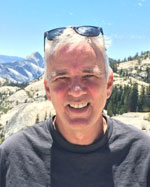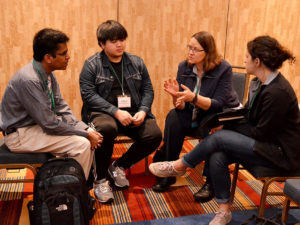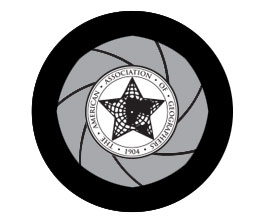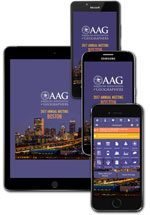Telling Our Stories, Speaking Out and Being Heard as Geographers
 Perhaps now more than ever geographers need to tell their stories, speak out and make their voices heard. In a world that seems increasingly divisive politically and socially, and where the fact-based discourse and decision-making we value is under threat, there is much that we find of concern and much with which we feel we should publically engage. In this column I share my thoughts on three aspects of communicating as geographers with the public, policymakers and each other.
Perhaps now more than ever geographers need to tell their stories, speak out and make their voices heard. In a world that seems increasingly divisive politically and socially, and where the fact-based discourse and decision-making we value is under threat, there is much that we find of concern and much with which we feel we should publically engage. In this column I share my thoughts on three aspects of communicating as geographers with the public, policymakers and each other.
Telling Our Stories Beyond Academia
Let me begin with the question: Are the messages that geographers can convey about their research and the geographical perspective of newsworthy interest to the public? Or, is it the case that our studies and perspectives as geographers are generally too specialized and arcane to elicit interest by the press and the general public? A simple online search will soon dispel that latter illusion. Searching Google News for the stories from the past month or so that featured the work of geographers yields a rich and varied trove of newsworthy accomplishments and pronouncements. These broadcast, print and online stories about the work of geographers span a wide spectrum of research interests including topics such as Russian activities in the Arctic, air pollution in Canadian cities, regional benefits of wind-generated electricity, the pervasive role of humans in U.S. wildfire ignitions, Islamic finance practices, and potential problems to U.S. water affordability. Geographers, through their research and informed opinions, have much to say to the public on the myriad challenges facing the world today.
Although geographers do have much to tell the public, academics as a whole have often been reticent to engage with the press for various reasons. Some feel it is unseemly to be seeking public attention and scholars should not be “bragging” about their work. Others feel they do not have the time for public engagement, and besides it is someone else’s job to deal with the press and otherwise communicate beyond the academic community. Some are simply uncomfortable in the spotlight. I would argue that all of the above are excuses in which we cannot afford to indulge. For our discipline, our universities and in support of informed policy-making we have a responsibility to actively engage with the public in regards to our geographical studies and perspectives. My reasoning is as follows. We often decry that geography is not valued by some of our academic colleagues, our administrators or the public. How many times have I heard geographers bemoan that our discipline needs to be seen as more than the memorization of national capitals and the world’s highest mountains? The most expeditious way to influence both the public and policy-makers about the scope and value of geography is through press coverage of our work and findings. We can describe the breadth and depth of geography all we want on our departmental websites, but those pronouncements do not have the wide reach and impact on the public that an article in the newspaper or an appearance in a television documentary does. If you want to make real impact on a politician, get a spot in the newspaper, on television or the radio either contradicting or supporting their position based upon your own research and findings. Also, don’t think that academic administrators or colleagues in other departments are immune to being positively influenced by press coverage of our discipline. A dean or president likes nothing better than to read or view press coverage of the work produced by their university. For our discipline and for the public, geography should be part of the greater discourse on the issues of our times, but it is up to geographers themselves to make sure this happens.
How then do we get our stories heard and retold by the media? First, we must recognize that some things we produce will be of more public interest than others. Stories that are likely to be picked-up are those that relate to contemporary issues of concern to the public and policy makers. To be newsworthy there must also be new information or novel new insights provided. The stories from Google News I cite above provide examples of this. In addition, historical and cultural studies can be of wide public interest. One example is the work of geographer Amy Hessl of the University of West Virginia on climate change and the conquests of Genghis Khan. Her research has received considerable national and international press coverage. Beyond published original research, geographers often have informed perspectives on contemporary issues that can be shared directly by submitting Op Ed pieces to local or national newspapers. These 400- to 600-word pieces are tricky to write, but can have great impact. As an example, let me draw your attention to a 2016 Op Ed on climate change and university divesture strategies which was published in The Salt Lake Tribune by Emily Nicolosi, a Ph.D. student in the University of Utah, Department of Geography.
Second, we have to be proactive in getting our stories and perspectives known. It is important to get to know our campus press officers and inform them about our expertise. The media often is in desperate need of experts to interview on breaking news stories. They will often turn to campus press offices for experts. Geographers should make the effort to ensure they are on those campus lists of experts. In addition, when the call comes for an interview and you feel qualified – take the plunge and speak to the media. If a press officer and the media know you will respond, you are likely to be sought more frequently. In addition to funneling interview requests to geographers, campus press officers can produce press releases on new research. This will help draw media attention to your findings. It is important that you work with the press office well before your study is published online or in print. You will likely need to be involved with developing and editing the release and this takes time. As a start, perhaps invite the appropriate press officer to a faculty meeting to receive a briefing on their roles and inform them of your expertise. For those of you attending the AAG Annual Meeting in Boston, Vice President Derek Alderman will be leading a session on effective communication for geographers. I highly recommend taking advantage of this opportunity, if you can.
Speaking Out
 Recent political events in the U.S., such as the current travel ban on citizens of six predominantly Muslim countries, or events outside the country, such as the purge of academics in Turkey, have increased the desire of AAG members to not just tell the story of their own work, but to speak out on political decisions that negatively impact geographers and other academics and students. In addition, as I wrote in an earlier column, certain legislative actions such as Senate Bill 103 take direct aim at denying U.S. Federal funds for selected types of geospatial data and geographical research. Such actions require geographers to speak out. Members often turn to the AAG to be a voice in speaking out on such issues. The AAG takes these matters very seriously and has issued public statements on such troubling actions and joined with other associations to combat them. An example is the effort being made to combat SB 103 and its restriction on geospatial data related to racial inequality. The AAG has not only issued a public statement, but has built a coalition that includes groups such as the NAACP to oppose this Bill. The association will continue to embrace such actions. Because of the need to more effectively convey information on such issues and let members know of AAG actions, we have established an online Policy Action Page and urge you to take advantage of this to stay informed.
Recent political events in the U.S., such as the current travel ban on citizens of six predominantly Muslim countries, or events outside the country, such as the purge of academics in Turkey, have increased the desire of AAG members to not just tell the story of their own work, but to speak out on political decisions that negatively impact geographers and other academics and students. In addition, as I wrote in an earlier column, certain legislative actions such as Senate Bill 103 take direct aim at denying U.S. Federal funds for selected types of geospatial data and geographical research. Such actions require geographers to speak out. Members often turn to the AAG to be a voice in speaking out on such issues. The AAG takes these matters very seriously and has issued public statements on such troubling actions and joined with other associations to combat them. An example is the effort being made to combat SB 103 and its restriction on geospatial data related to racial inequality. The AAG has not only issued a public statement, but has built a coalition that includes groups such as the NAACP to oppose this Bill. The association will continue to embrace such actions. Because of the need to more effectively convey information on such issues and let members know of AAG actions, we have established an online Policy Action Page and urge you to take advantage of this to stay informed.
Aside from written statements, group rallies have a long history as a mechanism for allowing collective voices to speak out on pressing political and social issues. In this vein, the AAG is partnering with other associations such as the American Association for the Advancement of Science, the American Geophysical Union and the Consortium of Social Science Associations for the March for Science in Washington, D.C., on April 22. This march is organized to allow “people who support scientific research and evidence-based policies to take a public stand” and is based on the premises of support for “all races, all religions, all gender identities, all sexual orientations, all abilities, all socioeconomic backgrounds, all political perspectives, and all nationalities“ and “Our diversity is our greatest strength.” I will be in Washington, D.C., to participate in the March for Science and invite you to join the AAG and me in speaking out in support of the value of science and evidence-based policies. In addition there are 360 satellite events around the world in which geographers who are supportive can take part on April 22. Please do let the AAG know if your department is involved in one of these satellite events or would like to join AAG’s activities in Washington.
However, statements and group actions by an association such as the AAG are not enough for geographers to speak out to their fullest effect. A great deal of impact can be generated by geographers taking individual actions to communicate their views. Such actions include Op Eds and letters to the editor in newspapers and online blogs. We need more geographers to speak up in this manner. In addition, there is great power in many individuals contacting individual policy makers and expressing the same concern. As an association the AAG can produce a single statement on an issue, but our membership has the capacity to issue some 11,000 individual statements. There is strength in such numbers when it comes to public policy, but to realize that strength individual members must accept the responsibility and take the time to themselves add their own voice to the chorus. Members can contact the president and U.S. senators, representatives and state-elected officials using the online USA.GOV portal. With this mechanism you can let your own representative know your concerns and also make your voice heard by the authors of legislation you object to or support. Similar portals are available in other countries such as Canada and the U.K. I urge you to also consider using your voice to speak out by individually contacting policy-makers on the issues about which you have concerns.
Being Heard
The communication goals of an association such as the AAG cannot simply be to provide a platform for issuing public statements and organizing actions such as public rallies. A central responsibility is to provide for communication between members to exchange views on critical issues, develop reasoned positions and then collectively decide on appropriate courses of action. Through our publications, knowledge communities, annual meetings and other activities, the AAG strives to provide this service. Disagreements will inevitably arise on how to deal with contentious issues, but we all benefit from reasoned and respectful exchanges of ideas of developing consensus for our actions. As members of the AAG, we must seek to not just be heard ourselves, but to allow other members to also be heard, even if their perspective or proposed actions may differ from our own.
The annual meeting in Boston will provide many opportunities for members to speak, be heard and be informed on the critical issues we face in the new political world in which we live. Opportunities will range from open discussions with AAG presidential leadership on responses to current U.S. policy changes, many sessions on human rights and talks by international thought leaders such as David Harvey, Noam Chomsky, Rush Holt and Jim Hansen on issues directly related to today’s challenges. Although the AAG has made arrangements for proxy and electronic presentations for citizens of Iran, Libya, Somalia, Sudan, Syria and Yemen so they will not be silenced, I bitterly regret their physical absence, and thank all the AAG members and staff who have worked, and will continue to work, on their behalves. I look forward to meeting with those of you who will be in Boston to join together and help develop strategies for how we as individual members, and the AAG as an association, can tell our stories, speak out and be heard.
Join the conversation on Twitter #PresidentAAG
—Glen M. MacDonald

 Boston’s cultural scene is vibrant in all seasons. From museums and performing arts to interactive festivals and outdoor concerts, Boston is abuzz with activities for cultural enthusiasts.
Boston’s cultural scene is vibrant in all seasons. From museums and performing arts to interactive festivals and outdoor concerts, Boston is abuzz with activities for cultural enthusiasts. The Jobs & Careers Center will be located in Rooms 203, 204 & 205
The Jobs & Careers Center will be located in Rooms 203, 204 & 205  Would you like to know more about the work of the AAG throughout the year, beyond the Annual Meeting? Are you interested in learning about additional resources and opportunities available to you through the AAG? Check out a new feature at the 2017 Annual Meeting in Boston, our AAG Snapshots series!
Would you like to know more about the work of the AAG throughout the year, beyond the Annual Meeting? Are you interested in learning about additional resources and opportunities available to you through the AAG? Check out a new feature at the 2017 Annual Meeting in Boston, our AAG Snapshots series! Get the most from your AAG 2017 Boston experience with the mobile app. Enjoy an interactive experience on your Apple, Android, BlackBerry and other mobile devices during the annual meeting. If you’re a laptop user or have a Windows phone, there’s also a Web version for your devices.
Get the most from your AAG 2017 Boston experience with the mobile app. Enjoy an interactive experience on your Apple, Android, BlackBerry and other mobile devices during the annual meeting. If you’re a laptop user or have a Windows phone, there’s also a Web version for your devices.